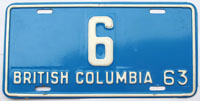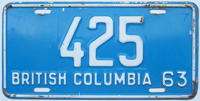|
British
Columbia Passenger License Plates
|
||||||||||||||||||||||||||||||||||||||||||||||||||||||||||||||||||||||||||||||||||||||||||||||||||||||||||||||||||||||||||||||||||||||||||||||||||||||||||||||||||||||||||||||||||||||||||||||||||||||||||||||||||||||||||||||||||||||||||||||||||||||||||||||||||||||||||||||||||||||||||||||||||||||||||||||||||||||||||||||||||||||||||||||||||||||||||||||||||||||||||||||||||||||||||||||||||||||||||||||||||||||||||||||||||||||||||||||||||||||||||||||||||||||||||||||||||||||||||||||
Quick Links: |
The period between 1931 and 1976 is considered to be the "Prison Era" when BC plates were manufactured by inmates at Oakalla Prison in Burnaby. |
* * * * * |
| 1955 | |||||||||||||||||||||||
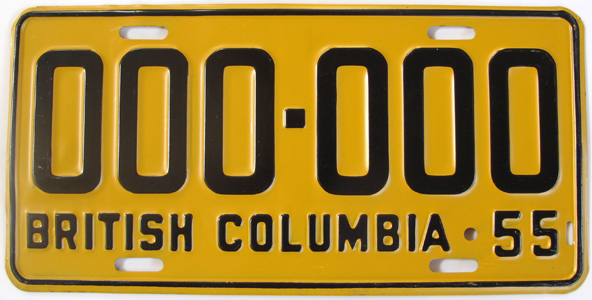
|
|
||||||||||||||||||||||
The reduced size of the plates - 2 inches shorter than the 1952 base - precluded the retention of the Totem emblem, but Duker was convinced the “Totemland” slogan was worthwhile and “won't cost the government a five-cent piece, the word could easily be included ... [and] if people elsewhere don't know what the word means, they will ask.”
It was also casually noted that the colours of the 1955 plates would be the reverse of the colours used on the 1954 renewal tabs; black-on-yellow. This should not have been controversial as yellow had been used as the background colour as recently as 1949 and prior to that in 1939 with variations of yellow and orange appearing in 1933 and 1927. The colour was also commonly used by California without seeming incident. The history of license plates - regardless of the jurisdiction - is, however, littered with “bun fights” (being a heated altercation, but one that is ultimately of no importance), and when the 1955 BC license plates were released 10 months later, buns would fly! |
| Gallery | |||
1-digit |
 |
||
Holland let loose with the following statements (many of them unfounded):
None of this was surprising given Holland's membership and involvement with the Totem-Land Society and professed affinity for a Totem design on BC license plates. Equally unsurprising was the Association's decision to try and recruit the B.C. Automobile Association (BCAA) to help it lobby the Attorney-General, Robert Bonner, to include an emblem and/or slogan for the 1956 license plates.
After all, Harry Duker, the Secretary of the Totem-Land Society, was also a Director of the BCAA and would try to use his perch to support Holland as well as advocate for the cherished “Totemland” slogan with Attorney-General Bonner. Duker also began a letter writing campaign to the major Vancouver newspapers pressing the case for “Totemland” on BC's 1956 license plates but, in a rare instance of disunity, the newspapers did not fall in-line behind the tourism boosters! Instead, both the Vancouver Province and Vancouver Sun ran stories downplaying Holland and Duker's over-wrought opinions of the new plates. In a wholly random and un-scientific survey, the Sun asked an assortment of passersby their opinion of the 1955 plates, and a majority responded that they couldn't have cared less (J.G. Ellett offered that “they look kind of corny to me”). |
 |
 |
Writing in the Vancouver Sun, Harold Weir (opponent of all totem poles) reminded his readers that the Tourism Association was not “the supreme arbiter of taste in these parts ... [and that it] should remember that licence plates are primarily for purposes of identification, not for ornament, and the first requirement of a licence plate is that it consist of a combination of colors which permits the identifying figures to be easily and quickly distinguished.” Even Ed Simmons felt compelled to write another Letter to the Editor of the Vancouver Province newspaper - entitled “Likes New Car Plates” - in order to congratulate “those responsible for the designing and production” of the 1955 license plates (primarily because it did not include a totem pole!).
But, the BCAA did agree that some sort of slogan should be included on BC license plates and reconfirmed its 1950 resolution of support for “Totemland”. The Motor Vehicle Branch (MVB) clarified that it did try to pick unique colours that weren't likely to conflict with neighbouring jurisdictions; “We have a pretty good idea what the other fellow is going to do” and the yellow used on the 1955 plates met this requirement. Robert Bonner, the Attorney-General, also confirmed that there was no space on the new standard license plate design for a slogan such as “Totemland”, which Duker had again pitched to him, or other suggested slogans such as “Business Moves Westward”.
The Association resolved to advocate for an agreement with Washington State to alternate green-and-white colour schemes on license plates to “keep the Evergreen idea before the public eye.” As can been seen in the license plates from subsequent years (shown below), this idea was never taken up by the province. In August, it was further announced that a group of Tourism Association members would be travel to Victoria in the coming months to discuss the idea of a slogan with the government, and out of the spotlight of the local press. |
For many decades (as was seen in the previous pages) an informal grace period had existed whereby motorists could sometimes go weeks beyond the end of the registration year before the police would begin to crack down on the use of expired plates (this had eventually been eliminated by the 1950s). Yet, no similar grace period had ever been applied to motorists wanting to affix the coming year's license plates to their car early (e.g. prior to February 1st). This slowly began to change in the early 1950s, with plates beginning to be sold on January 1st but not allowed to be mounted until February 1st. In 1955, motorists were finally allowed to display their new license plates prior to February 1st on the proviso that carried their soon to be expired 1954 plates with them in their vehicle! To eliminate this hassle and also to entice car owners to renew early in order to avoid rushes throughout the month of February, legislative changes were implemented to allow new license plates to be displayed in January.
Until then, confusion ensued with some municipalities, such as Oak Bay not enforcing, but others such as Victoria and Saanich requiring 1955 plates not be mounted until Feb. 1st - creating a gauntlet for drivers attempting to navigate the Capital region. |
Accordingly, the 1955, 1956 & 1957 were all stamped with extra slots that would have allowed for the covering of the date with a renewal tab. The reason given by the Motor Vehicle Branch (MVB) was in case of a major steel shortage that limited the province's access to steel for new plates. |
 |
 |
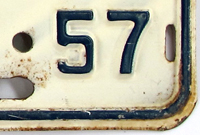 |
The plate was issued in October of 1955 to a Victoria motorists named Mr. Scales. |
* * * * * |
| 1956 | |||||||||||||||||||||||
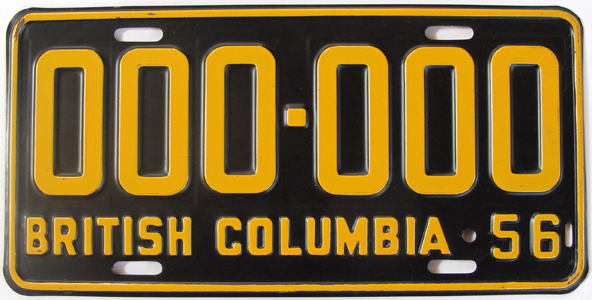 |
|
||||||||||||||||||||||
An interesting bit of trivia; this was the first time the same colours had been reversed three years in a row, from the yellow-on-black for the 1954 renewal tab, to black-on-yellow for the 1955 series to yellow-on-black for 1956. While registration information for 1955 is not available, news reports from the time stated that 400,000 car and truck plates were being manufactured. It is thought 330,000 of these were probably for passenger cars. |
| Gallery | |||
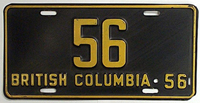 |
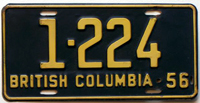 |
||
It is thought this “obsolete” equipment was the machinery bought from J.R. Tacey & Son in 1930 (at a cost of $30,000). The supplier of the new equipment was the Screw Machine Products Company of Portland Oregon (as no Canadian firm was seen as capable of providing the necessary equipment). |
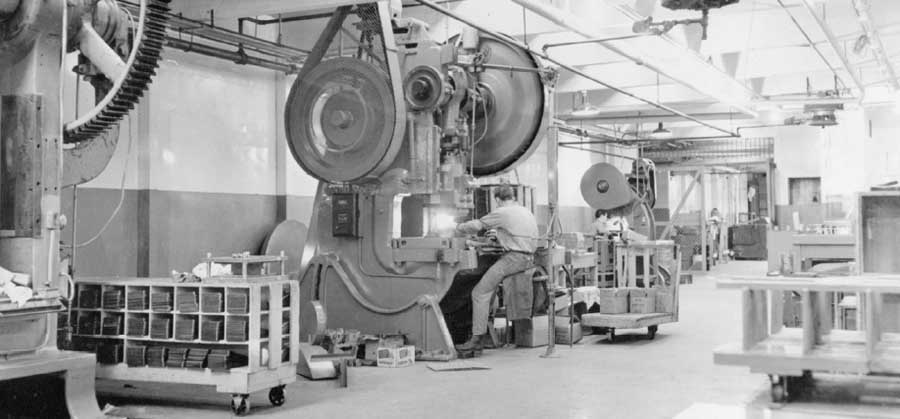 |
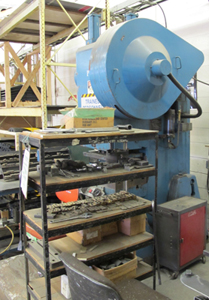 |
Shown above is a photo of the Plate Shop operating inside of WestGate sometime in the 1950s and after the province had invested in new equipment to replace that which it had bought from J.R. Tacey & Son over 20 years earlier (and which had probably dated to 1917, or earlier). When the Plate Shop at Oakalla was shut-down in the mid-1970s and the work out-sourced to private companies (operating out of province) the license plate making equipment was mothballed. With the push to promote local businesses in the early 1980s and the awarding of the license plate contract to Astrographic Industries Limited of Surrey, the province provided Astrographic with the old Oakalla Plate Shop equipment in order to help it get its new plate making business up and running. Some of this equipment was still being used (sparingly) by Astrographic shortly before it exited the license plate making field in 2013, as can be seen in the image at left taken as Astrographic's facility in 2012. |
An interesting aside about the Plate Shop is the number of times it served as the backdrop for various prison breaks from Oakalla:
|
This can primarily be attributed to the meeting between representatives of the Vancouver Tourism Association and Attorney-General Bonner in the late fall of 1955, when it was revealed that Bonner “had approved the idea in principal” of some “descriptive emblem or legend” on the 1958 license plates. Taking a different tact than in 1954-55, the Association announced it was “making no suggestion as to what should go on the plates ... [and] all it want is something which will publicize B.C.” It was further reported that “the mechanics of the 1957 plates are too far along to be changed” to include an emblem or slogan.
Duker was able to convince Arthur Turner, CCF member for Vancouver East to ask the Attorney-General in the Legislature if he would do anything to put the “Totemland” slogan on BC license plates. It was report that “the A.G. conveniently lost his notes on this, so Mr. Turner didn't find out.”
72% of respondents said “Yes” compared to 10% who said “No” and 18% who didn't care. In terms of preference, 19% preferred a slogan, 51% preferred an emblem while 30% had not preference. |
Accordingly, for the 1956 registration year motorists could affix their new license plates to their cars as soon as they had purchased them, with sales commencing on January 1, 1956. |
Despite the alarmist nature of the warning (and slur against collectors), it is the considered opinion of everyone here at BCpl8s.ca that the person asking for plates was likely a genuine collector. A criminal doesn't ask. By the mid-1950s, the collecting of license plates had reached a critical mass that the formation of the Automobile License Plate Collectors Association (ALPCA) became feasible (and occurred in 1954). ALPCA has, since its inception, been dedicated to the promotion of license plate collecting, research, the exchange of information and plates, and the benefits of sharing a common interest with people all over the world. |
* * * * * |
| 1957 | |||||||||||||||||||||||
 |
|
||||||||||||||||||||||
On December 12, 1956, it was announced that the colour of the 1957 license plates would be blue figures on a white background. With the focus on the upcoming Centenary celebrations in 1958, the 1957 license plates and their non-controversial colour scheme, generated little notice or debate. |
| Gallery | |||
 |
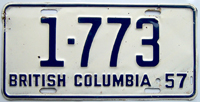 |
||
This is because the blue-and-white colour scheme was the same one that Alberta had decided to use. By the time it was realized the plates would have the same colour, it was too late to do anything about it. The MVB was hopeful the different layout on the Alberta plate (date at the top and use of letters) would make it easy to differentiate from BC plates. While the MVB spokesman confidently declared “this has never happened before”, it did happen on occasion, such as in 1942 when both provinces issued white-on-blue coloured plates. |
.jpg) |
* * * * * |
| 1958 | |||||||||||||||||||||||
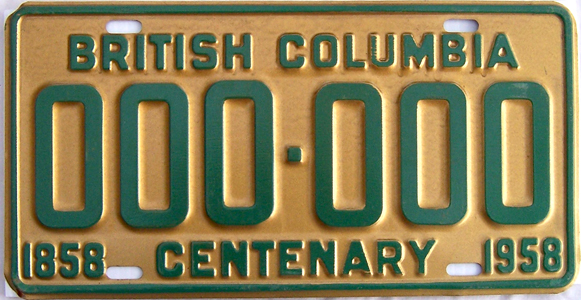 |
|
||||||||||||||||||||||
The plates would display a gold-on-green colour scheme to denote the importance of the forestry industry to the provincial economy (green) and the historical significance of the 1858 Fraser Canyon Gold Rush to the formation of what would become British Columbia and would also be “appropriately worked to mark the occasion”.
It is assumed the colour change was made due to the difficulties of painting gold over green, however, given the green was to represent the province's forest industry it would have made a better symbolic background. |
| Gallery | |||
The atmosphere in various offices of the Motor Vehicle Branch (MVB) described as akin to “a department store on the day before Christmas” and it is likely the hype in the lead up to the centennial celebrations planned for 1958 played a large part in the demand for the plates by motorists.
And with that, the next phase in the “License Plate Colour” bun fight had begun! The Vancouver Sun newspaper soon followed with a blistering editorial, declaring:
Even the Vancouver Province, the perennial supporter of “doctoring up licence plates [to] suit boosters and promoters” conceded “our 1958 Centennial licence plates seem to be a bit of a bust in more ways than one.” Lamenting what could have been, the Province suggested the centennial booster plates, which had been produced in the original gold-on-green colour scheme, was the superior design: |
The unique colours and corny slogan (it wasn't really BC's centennial, this event had gone unmarked 9 years earlier in 1949) set it apart from almost all the plates that proceeded it - except the Totem. This duality is captured by a Letter to the Editor penned by Victor Campbell in September of 1958 (at right). |
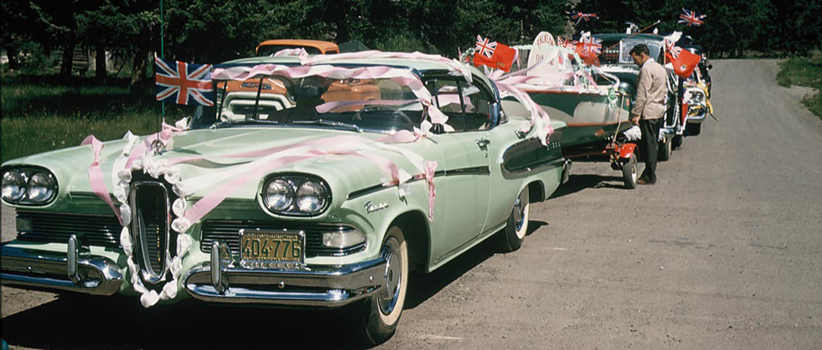 |
| Colour photos from this era are rare, but the example above provides an indication of the legibility challenges associated with the 1958 colour scheme, especially from any distance. |
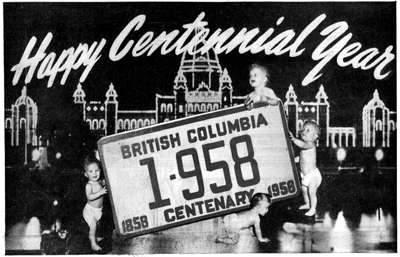 |
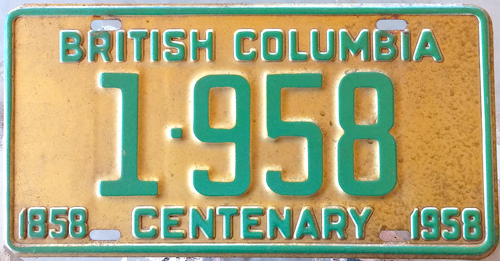 |
Take the No. 1958, which held significant importance in 1958 as the Social Credit administration of WAC Bennett used this date to celebrate the 100th anniversary of the Crown Colony of British Columbia's founding. It is now known that Bennett's Attorney General, Robert Bonner (1952-1968), was issued this number for 1958. We wonder then, who was issued the No. 1858 (pictured above) for that year? |
* * * * * |
| 1959 | |||||||||||||||||||||||
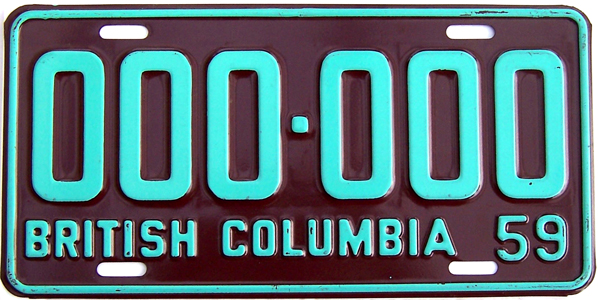 |
|
||||||||||||||||||||||
The more common reference would be “turquoise numbers on a marron background” and these colours were selected to provide a greater contrast than the 1958 plates.
|
| Gallery | |||
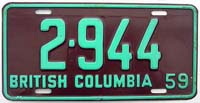 |
|||
 |
|||
Within days of the 1959 license plates being released, the next, albeit more muted phase in the “License Plate Colour” bun fight had begun!
The Vancouver Sun asked, if “with a little more effort it would have been possible to produce a more distressing color combination for the 1959 license plates”? |
 |
Foremost amongst these was Harry Duker and his “Totemland” slogan, whom he convinced Vancouver Council to ask the provincial government to print on the 1959 license plates (which Harold Weir decried, yet again, in the pages of the Vancouver Sun). Others slogan options also emerged, including H.J. Sceats of Victoria, who put forward the idea of “Sportsmen's Paradise” in early November of 1957 for possible inclusion on the 1959 plates (shown at left).
The Prince George Board of Trade objected to the “Sportsmen's Paradise”, not because Louisiana would be using it first, but because it would only appeal to about 10% of tourists. Instead, something with a broader appeal, such as "Opportunities Unlimited" should be considered. |
Palindrome: "a word, phrase, or sequence that reads the same backward as forward" - and also a fun subset of license plate collecting for the truly dedicated:
|
||
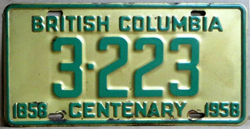 |
||
* * * * * |
| 1960 | |||||||||||||||||||||||
 |
|
||||||||||||||||||||||
Similar to 1957, and despite the gaudy colours, the 1960 license plates generated little debate. |
| Gallery | |||
 |
|||
 |
|||
In July of 1959, Harry Duker, through the Vancouver Tourist Association, began advocating for the inclusion of a “Totemland” slogan on the 1960 license plates. The Association sent a letter to the government with its request and also sought allies, including the City of Vancouver Council. Even Edward Simmons is believed to have re-joined the fight against the Totem, writing anonymously to the Vancouver Sun (under the nom-de-guerre “Anti-Totem”) asking Council to reject Duker's entreaty:
As can be seen in the final design of the 1960 license plates, the province shared Vancouver Council's assessment and the slogan was not used. |
* * * * * |
| 1961 | |||||||||||||||||||||||
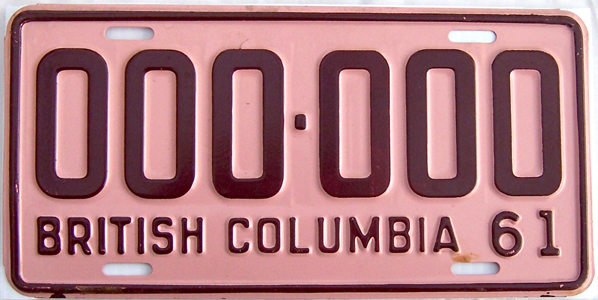 |
|
||||||||||||||||||||||
The colours of the 1961 license plates had been announced unusually early - in September of 1959 - as a result of the “Pastel Policy” that had been adopted by the Motor Vehicle Branch (MVB) in 1958.
The colours that were settled upon where marron figures on either a coral or “shrimp pink” background. |
| Gallery | |||
 |
|||
And with that, the next phase in the “License Plate Colour” bun fight (with a side of shrimp) had begun! |
|
For others, however, the “Pastel Policy” had succeeded in creating highly legible plates. According to a high ranking RCMP official the plates would “take some getting used to. Although the colors are a little odd, I think they are fine. The figures stand out well and that is what concerns us most of all.”
Despite this praise from officialdom, dissatisfaction with the plate colours continued to grow, as reflected in an Editorial (“Shrimp color is for shrimps ...”) printed by the Vancouver Province newspaper:
|
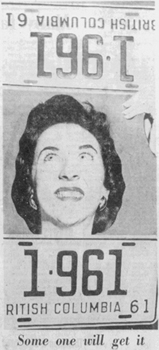 |
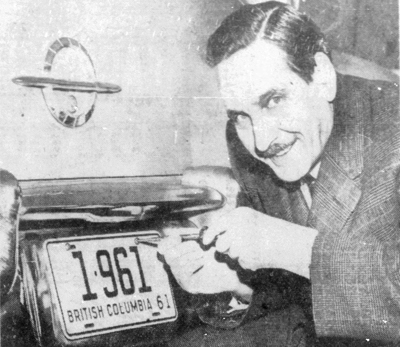 |
|
An interesting bit of trivia, the 1961 license plate No. 1961, when held upside down displays the same number (see image at far left). Apparently this will not occur again until the year 6009. Showing this trick is Dianne Dewdney of the MVB. Two weeks later the No. 1961 plate was issued to Don Mollison, Manager of the B.C. International Trade Fair (shown in middle). Amazingly, the plate survived and is now in the hands of collectors (see image above). |
Somewhat surprisingly, the call for a slogan on the 1961 BC license plates did not come from Harry Duker! Instead, the Kamloops Board of Trade resolved to ask the BC Chamber of Commerce to petition the provincial government to include a “suitable slogan extolling the province.” Even more surprising (or not?), delegates to the Chamber's annual convention defeated the the license plate slogan resolution! |
| Minor Die Variations: 1961 date stamp | |||
|
|||
| Here is one of those interesting, but ultimately not very significant variations that can be found in some of the dies used to stamp out the plates. It is assumed that additional plates produced late in the 1961 run begin to display the new '6' to be used in the 1962 series (which was probably already being manufactured). |
* * * * * |
| 1962 | |||||||||||||||||||||||
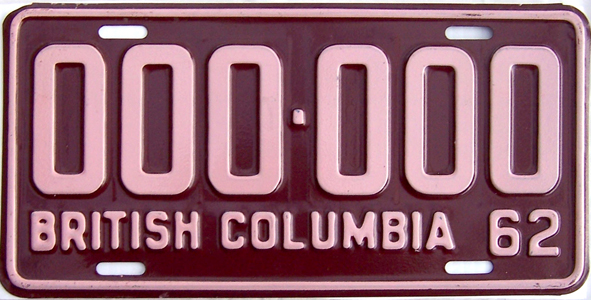 |
|
||||||||||||||||||||||
The difference this time, and in keeping with the Motor Vehicle Branch policy of generally using the same colours two years running, would be pink letters on a maroon background, the reverse of the 1961 colour scheme. In defending its decision, the government explained that as “nobody knows just how many cars there will be [in the] next year, it's hard to order the right amount of paint. But ... it's easier to come out with a close guess on the amount [to be used] over two years, and the savings have been quite considerable in the past.”
Nevertheless, the new colours were met with disdain by some motorists who complained they were “some of the worst combinations know to man”, a “disgrace” and “of all the provinces we in B.C. have the sickliest plates. And so I hear many saying.” |
| Gallery | |||
The colours used in 1961/62 prompted renewed discussions around the introduction of permanent license plates (with more traditional colours), which were becoming more common in other jurisdictions. The MVB, aware of these trends, offered a surprisingly candid overview of its thinking on the subject to the local press, stating that introducing a system like that used in Britain would require a license plate strong enough to last multiple years of use (something the 1952 Totem base had failed to do). The cost of such a set of plates was estimated to be $3.50, whereas the costs of the annual license plates BC was issuing in the late 1950s and early 1960s was estimated to be $0.25/set. Which meant the current system allowed for the production of 15 years worth of plates for the costs of a single permanent set of plates. Changing plates every year also allowed the police to easily identified scofflaws who had not paid their current registration and were driving on expired plates. While Britain did issue permanent plates, they also validated these through the use of annual windshield decals which carried their own cost and were not as easy for law enforcement to check when a car was being driven. The MVB was also still scared by the experience of the renewal tabs used in the early 1950s and the administrative costs and difficulties associated with these (e.g. “cross-indexing of numbers on plates and validating tabs”) that it felt it was still cheaper to issue annual plates. To support this position, it was pointed out that California had “lost track of more than 100,000 cars” with its system of registration decals. |
Here
is another one of those interesting, but ultimately not
very significant variations that can be found
in certain production runs; the omission of a dash between the first and second numbers on the first 1,000 plates with 4-digits (i.e. those between 1,000 and 1,999) in 1962:
|
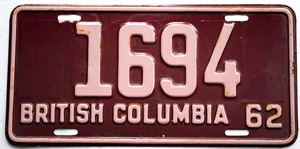 NO DASH |
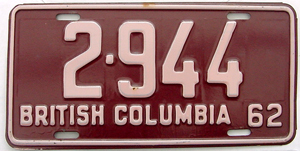 DASH |
What might be an even rarer variation is the missing dash on a 5-digit plate, such as the example shown below. As we have not seen many of these, it is hard to say howmany plates and in which block might be misisng the dash on 5-digit plates:
|
* * * * * |
| 1963 | |||||||||||||||||||||||
 |
|
||||||||||||||||||||||
|
| Gallery | |||
 |
|||
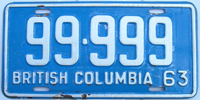 |
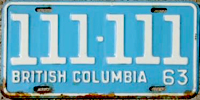 |
||
Quick Links: |
Antique | APEC | BC Parks | Chauffeur Badges | Collector | Commercial Truck | Consul | Dealer | Decals | Driver's Licences | Farm | Ham Radio | Industrial Vehicle | Keytags | Lieutenant Governor | Logging | Manufacturer | Medical Doctor | Memorial Cross | Motive Fuel | Motor Carrier | Motorcycle | Movie Props | Municipal | National Defence | Off-Road Vehicle | Olympics | Passenger | Personalized | Prorated | Prototype | Public Works | Reciprocity | Repairer | Restricted | Sample | Special Agreement | Temporary Permits | Trailer | Transporter | Veteran | Miscellaneous |
© Copyright Christopher John
Garrish. All rights reserved.

 In February of 1954, George Lindsay, the Superintendent of the Motor Vehicle Branch (MVB), announced that British Columbia would be adopting the new North American standard for license plate dimensions of 6" x 12".
In February of 1954, George Lindsay, the Superintendent of the Motor Vehicle Branch (MVB), announced that British Columbia would be adopting the new North American standard for license plate dimensions of 6" x 12". Hudson’s comments were prompted by the varied array of license plate designs that had taken shape over the preceding two decades as states steadily assumed responsibility for issuing “uniform” annual plates.
Hudson’s comments were prompted by the varied array of license plate designs that had taken shape over the preceding two decades as states steadily assumed responsibility for issuing “uniform” annual plates.
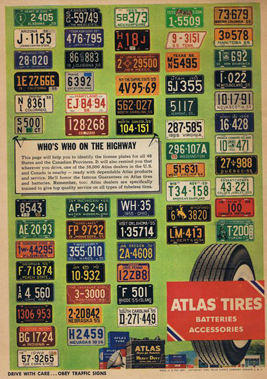
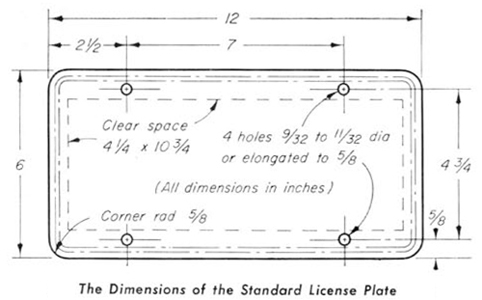
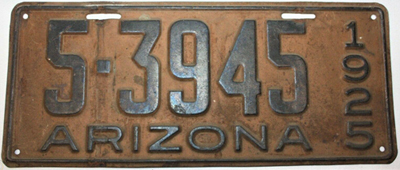
 Four days before Lindsay announced the introduction of the new 6” x 12” license plate standard, Harry Duker had traveled to Victoria to try and convince the government to include
Four days before Lindsay announced the introduction of the new 6” x 12” license plate standard, Harry Duker had traveled to Victoria to try and convince the government to include 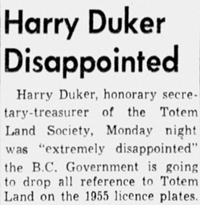 Alas for Duker, the provincial government resolved in April to not use any slogan on the 1955 license plates and even dropped the use of letters in the serial number. It was reported that “dies for the new plates [had] already been cast and Oakalla inmates [would] soon start manufacturing them.”
Alas for Duker, the provincial government resolved in April to not use any slogan on the 1955 license plates and even dropped the use of letters in the serial number. It was reported that “dies for the new plates [had] already been cast and Oakalla inmates [would] soon start manufacturing them.”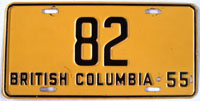
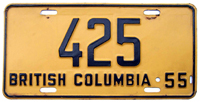

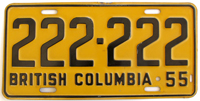
 The opening salvo in the epic “License Plate Colour” bun fight was launched by R. Rowe Holland (shown below-right) from his perch as a Director of the Vancouver Tourist Association.
The opening salvo in the epic “License Plate Colour” bun fight was launched by R. Rowe Holland (shown below-right) from his perch as a Director of the Vancouver Tourist Association.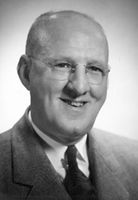
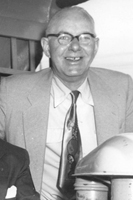

 Reading the public mood and the insignificance of the issue, the BCAA put some distance between itself and the Tourist Association declaring “there's nothing wrong with the color ... [and] that should be left to the government to decide. Colors are undoubtedly chosen so as not to conflict with other provinces and states.”
Reading the public mood and the insignificance of the issue, the BCAA put some distance between itself and the Tourist Association declaring “there's nothing wrong with the color ... [and] that should be left to the government to decide. Colors are undoubtedly chosen so as not to conflict with other provinces and states.”  Having failed to grain traction in its grudge-match with the province over license plate designs and slogans, the Tourism Association resolved at its next meeting to tamp down its rhetoric.
Having failed to grain traction in its grudge-match with the province over license plate designs and slogans, the Tourism Association resolved at its next meeting to tamp down its rhetoric.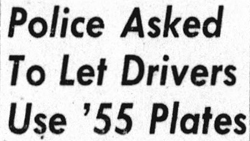

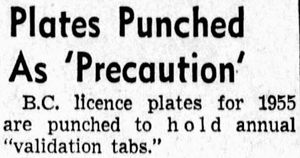 While the province had no plans of reverting to the use of renewal tabs so soon after the demise of the Totem base, it also recognized that sometimes events forced its hands.
While the province had no plans of reverting to the use of renewal tabs so soon after the demise of the Totem base, it also recognized that sometimes events forced its hands. While it took 20 years to go from issuing license plate No. 100-000 (1930) to No. 200-000 (1950), it took only five years for another 100,000 vehicles to be registered in the province and license plat No. 300-000 to be issued.
While it took 20 years to go from issuing license plate No. 100-000 (1930) to No. 200-000 (1950), it took only five years for another 100,000 vehicles to be registered in the province and license plat No. 300-000 to be issued. On November 12, 1955, it was announced that the colour of the 1956 license plates would be the reverse of the 1955 plates; yellow letters on a black background.
On November 12, 1955, it was announced that the colour of the 1956 license plates would be the reverse of the 1955 plates; yellow letters on a black background. 
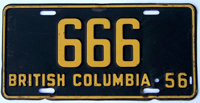


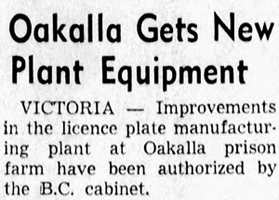 In December of 1955, the Provincial Cabinet authorised the purchase of new plate making equipment for the Plate Shop at Oakalla, which was to cost approximately $98,289.00 and was to replace equipment that was described by the media as being “obsolete and inadequate”.
In December of 1955, the Provincial Cabinet authorised the purchase of new plate making equipment for the Plate Shop at Oakalla, which was to cost approximately $98,289.00 and was to replace equipment that was described by the media as being “obsolete and inadequate”.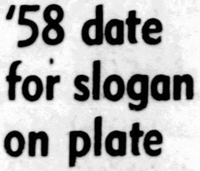 Following the epic 1955 “License Plate Colour” bun fight, the reception by Vancouver business groups and organizations to the 1956 license plates was decidedly silent - despite the plates utilizing the same colour scheme (albeit reversed).
Following the epic 1955 “License Plate Colour” bun fight, the reception by Vancouver business groups and organizations to the 1956 license plates was decidedly silent - despite the plates utilizing the same colour scheme (albeit reversed).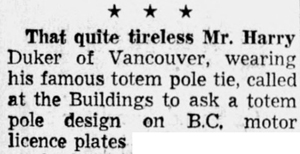 This didn't stop Harry Duker from making what was becoming his annual pilgrimage to Victoria in January of 1956 in order to lobby the government for a totem pole design on the forthcoming year's (1957) license plates.
This didn't stop Harry Duker from making what was becoming his annual pilgrimage to Victoria in January of 1956 in order to lobby the government for a totem pole design on the forthcoming year's (1957) license plates.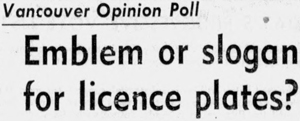 With the announcement of a possible slogan on license plates for 1958, the Vancouver Province newspaper commission a poll to see which residents preferred; a slogan or an emblem. The question participants in the survey were asked was:
With the announcement of a possible slogan on license plates for 1958, the Vancouver Province newspaper commission a poll to see which residents preferred; a slogan or an emblem. The question participants in the survey were asked was: Following the confusion that had occurred in 1955 when some municipal police decided to enforce the rule that new license plates could not be installed until February 1st, while others chose not to enforce, the province had amended the Motor Vehicle Act in March of 1955.
Following the confusion that had occurred in 1955 when some municipal police decided to enforce the rule that new license plates could not be installed until February 1st, while others chose not to enforce, the province had amended the Motor Vehicle Act in March of 1955.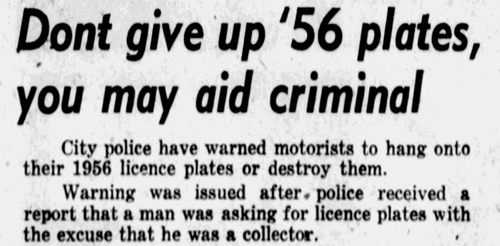 In January of 1957, Vancouver Police warned motorists affixing their new plates to hold onto their 1956 plates in case anyone asked for them.
In January of 1957, Vancouver Police warned motorists affixing their new plates to hold onto their 1956 plates in case anyone asked for them.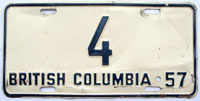
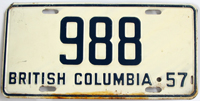
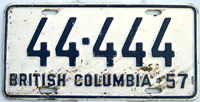

 Despite the Motor Vehicle Branch (MVB) claiming, as recently as 1955, that it communicated with neighbouring jurisdictions and tried to pick unique colours (e.g. “we have a pretty good idea what the other fellow is going to do”), the lines of communications broke down for the 1957 plates.
Despite the Motor Vehicle Branch (MVB) claiming, as recently as 1955, that it communicated with neighbouring jurisdictions and tried to pick unique colours (e.g. “we have a pretty good idea what the other fellow is going to do”), the lines of communications broke down for the 1957 plates.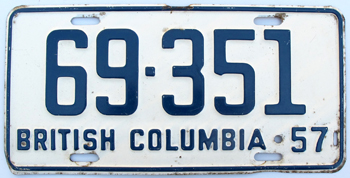
 On March 22, 1956, the Chair of the Province's Centennial Committee, Lawrie Wallace, announced at the annual convention of the Union of British Columbia Municipalities (UBCM) in Penticton that special Centennial license plates would be issued in 1958 to commemorate the anniversary.
On March 22, 1956, the Chair of the Province's Centennial Committee, Lawrie Wallace, announced at the annual convention of the Union of British Columbia Municipalities (UBCM) in Penticton that special Centennial license plates would be issued in 1958 to commemorate the anniversary.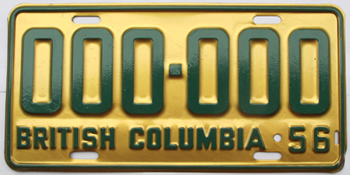

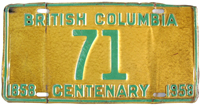
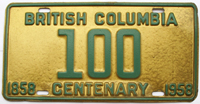

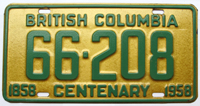
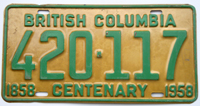
 Unlike in most other years when motorists waited to the last minute to buy their license plates, early reports from January of 1958 indicated that motorists were “rushing” to purchase the new Centenary plates, with sales up 20% from the same period in 1957.
Unlike in most other years when motorists waited to the last minute to buy their license plates, early reports from January of 1958 indicated that motorists were “rushing” to purchase the new Centenary plates, with sales up 20% from the same period in 1957. In keeping, however, with the theme of this period, within 4 days, police were advising motorists to keep their new 1958 plates clean of dirt as the green-on-gold colour combination was proving problematic and difficult to read (“a few splashes of mud would make the lettering illegible”).
In keeping, however, with the theme of this period, within 4 days, police were advising motorists to keep their new 1958 plates clean of dirt as the green-on-gold colour combination was proving problematic and difficult to read (“a few splashes of mud would make the lettering illegible”). Monte Roberts, a columnist for the Victoria Times newspaper echoed this sentiment, asking “who can see the plates well enough to read the numbers?” While a rhetorical question, Port Alberni Council answered a few weeks later when it resolved to send a complaint to the Attorney-General after one its Councilors was forced off the road by a bad driver but could not make out the license plate numbers due to the “hash-house pea-soup” colour scheme.
Monte Roberts, a columnist for the Victoria Times newspaper echoed this sentiment, asking “who can see the plates well enough to read the numbers?” While a rhetorical question, Port Alberni Council answered a few weeks later when it resolved to send a complaint to the Attorney-General after one its Councilors was forced off the road by a bad driver but could not make out the license plate numbers due to the “hash-house pea-soup” colour scheme.
 Much like the 1952 Totem license plate, the 1958 Centenary license plate inhabits one of those weird spaces wherein it failed the practicality test (e.g. it's illegible), but the same flaws that resulted in this failure have made it popular with collectors over the proceeding decades.
Much like the 1952 Totem license plate, the 1958 Centenary license plate inhabits one of those weird spaces wherein it failed the practicality test (e.g. it's illegible), but the same flaws that resulted in this failure have made it popular with collectors over the proceeding decades.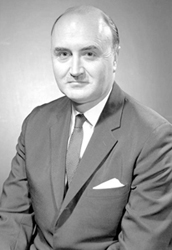 While BC was fairly democratic in how it allotted numbers below 3,000 in the period prior to 1970, having political connections certainly helped on occasion.
While BC was fairly democratic in how it allotted numbers below 3,000 in the period prior to 1970, having political connections certainly helped on occasion. On September 30, 1958, the first reference to the colours of the 1959 was reported by the press and was described as “dark-maroon background with Peacock-blue numerals, according to the MVB.”
On September 30, 1958, the first reference to the colours of the 1959 was reported by the press and was described as “dark-maroon background with Peacock-blue numerals, according to the MVB.” Following the outcry over the 1955 plate colours, the 1957 SNAFU in which the colours were the same as Alberta's, but primarily as a result of the legibility issues with the 1958 plates the Motor Vehicle Branch (MVB) adopted a policy of only using pastel shades to ensure the plates were easy to read and sufficiently different from the colours use by any other jurisdiction.
Following the outcry over the 1955 plate colours, the 1957 SNAFU in which the colours were the same as Alberta's, but primarily as a result of the legibility issues with the 1958 plates the Motor Vehicle Branch (MVB) adopted a policy of only using pastel shades to ensure the plates were easy to read and sufficiently different from the colours use by any other jurisdiction.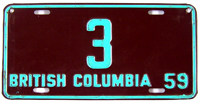
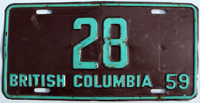
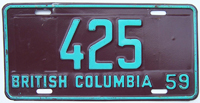
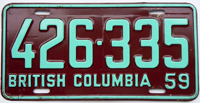

 Following the success of the “CENTENARY” slogan on the 1958 license plates, renewed efforts were made by various groups and individuals to have a more permanent slogan added to BC license plates.
Following the success of the “CENTENARY” slogan on the 1958 license plates, renewed efforts were made by various groups and individuals to have a more permanent slogan added to BC license plates.
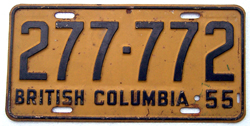
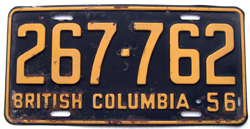
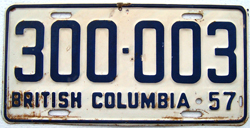

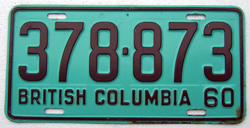
 On September 26, 1959, it was announced that the colours of the 1960 license plates would be the reverse of the 1959 plates; maroon figures on a turquoise background.
On September 26, 1959, it was announced that the colours of the 1960 license plates would be the reverse of the 1959 plates; maroon figures on a turquoise background.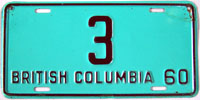
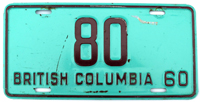

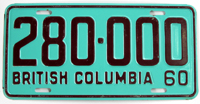
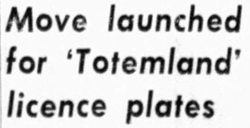 There is a saying that “persistence pays off” ... well, it is not true.
There is a saying that “persistence pays off” ... well, it is not true. 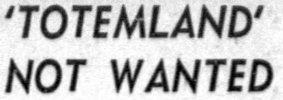 City Council ultimately resolved to not support the Association in its quest, declaring it did not want to “clutter plates up” with extra words.
City Council ultimately resolved to not support the Association in its quest, declaring it did not want to “clutter plates up” with extra words.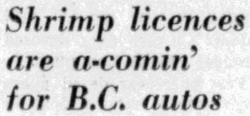 The Branch had already advised other provinces and nearby states of the colours it would be using for the next four years in order to avoid any conflicts and had begun testing at Oakalla in 1959 “to obtain a wearable pink paint” for 1961.
The Branch had already advised other provinces and nearby states of the colours it would be using for the next four years in order to avoid any conflicts and had begun testing at Oakalla in 1959 “to obtain a wearable pink paint” for 1961.
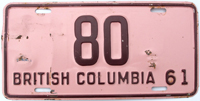

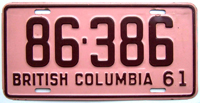
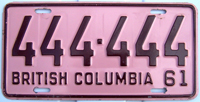

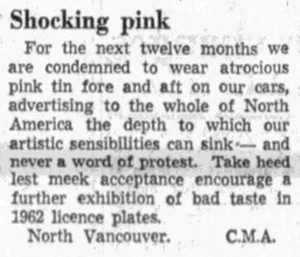 Response to the pink plates was mixed, with descriptions including:
Response to the pink plates was mixed, with descriptions including: Surveying all the new license plate colour combinations for 1961, the American Automobile Association (AAA) in Washington, DC, declared British Columbia's colours to be the most “exotic” on the continent, but “how that will blend with today's car colors is anybody's guess.”
Surveying all the new license plate colour combinations for 1961, the American Automobile Association (AAA) in Washington, DC, declared British Columbia's colours to be the most “exotic” on the continent, but “how that will blend with today's car colors is anybody's guess.” In another editorial, it was asked “who is the nut who chooses the colors for British Columbia's license plates? ... We urge the powers that be over in Victoria to transfer him with all dispatch to the dog-catching department.” The person behind the colours was, of course, MVB Superintendent George Lindsay.
In another editorial, it was asked “who is the nut who chooses the colors for British Columbia's license plates? ... We urge the powers that be over in Victoria to transfer him with all dispatch to the dog-catching department.” The person behind the colours was, of course, MVB Superintendent George Lindsay.


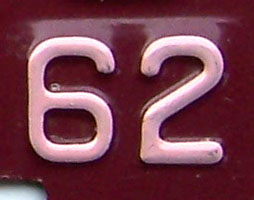
 On July 19, 1961, the provincial government confirmed that the pink and maroon colours - “which caused a colorful furore” that year - would be used again on the 1962 license plates.
On July 19, 1961, the provincial government confirmed that the pink and maroon colours - “which caused a colorful furore” that year - would be used again on the 1962 license plates. 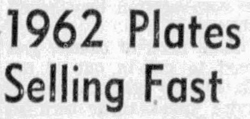 Seeming to confirm motorists distaste for the 1961 colour scheme, sales of the 1962 license plates were reported to be “faster than usual” during the first week they became available for sale in January of 1962.
Seeming to confirm motorists distaste for the 1961 colour scheme, sales of the 1962 license plates were reported to be “faster than usual” during the first week they became available for sale in January of 1962.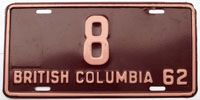
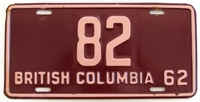
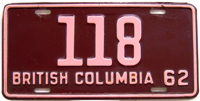
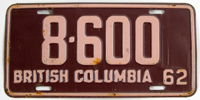

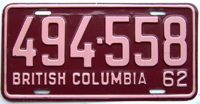
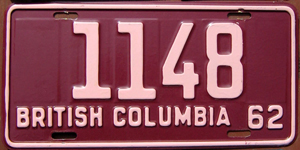


 On May 14, 1962, Earle Westwood, Minister of Commercial Transport, announced that the 1963 license plates would be blue and white - “a complete contrast to the marron and pink of the [previous] two years.”
On May 14, 1962, Earle Westwood, Minister of Commercial Transport, announced that the 1963 license plates would be blue and white - “a complete contrast to the marron and pink of the [previous] two years.”
